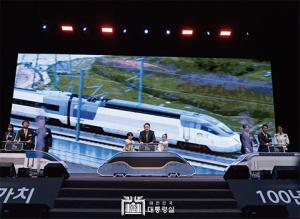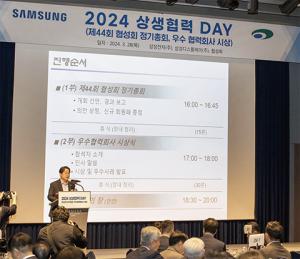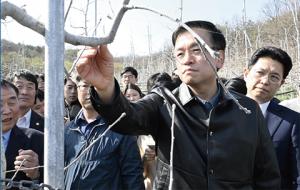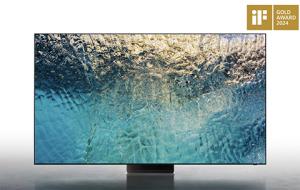 |
||
먹의 신비함을 채색하는 탁양지의 산수화
탁양지 화가
동양의 풍경을 담은 산수화는 시로 비유하면 한 줄 읽으면 품격 있는 만연체 시조, 다 읽으면 운율이 넘치는 4구체다. 그래서 직관적으로 보는 그림이 아니라 훑어가며 읽는 그림이다. 섬과, 바다로 이루어진 통영을 고향으로 둔 덕에 그의 작품은 자연스럽게 고향을 담아내고 있다. 눈에 담고 가슴으로 느낀 고향을 먹과 채색으로 완성해나가면서 이제는 어느 덧 통영의 화가로 거듭났다.
동양화의 필법과 정서를 담은 탁양지 화가는 산수를 쓰고 그리는 현대의 동양화풍에서 가장 독보적인 영역을 확보한 작가 중 한 사람이다. 품격과 멋을 간직한 관념산수화의 정신적인 여유, 현대인의 감수성을 자극하는 재구성을 보여주는 탁 화가의 작품세계를 소개한다.
풍부한 마음의 눈으로 그린 심화(心畵)
전통화법의 재구성은 언제나 고답성과 파격 사이에서 영역다툼을 한다. 그러나 마치 전통가옥 안에 있는 로하스적 가구가 무리 없이 나전칠기의 문양을 얹고 있을 때처럼, 동양화 고유의 속성인 감성과 조화로 극복하는 과정을 보는 것은 즐거운 일이다. “그림을 그린다기보다는 종이 위에 산수를 쓰고 그리는 작가가 되고 싶다”고 말하며 자연친화적인 재해석을 담아 온 탁양지 화가의 그림에는 붓으로 그려낸 서사와 운율이 묵직함을 벗고 경쾌하게 표현된다. 대개 한국화의 진지함과 위트 사이에는 중국 화법에서 태생적으로 유래된 먹과 여백이 만들어내는 경계가 존재하게 마련인데, 탁 화가는 미술을 전공하며 중국 화법을 독학으로 연습하며 대담한 오리지널리티를 지닌 화법을 완성했다고 한다. 배경을 투시하고 재배치하는 마음의 눈이 필요한 산수화에서, 탁 화가는 심원과 평원을 기준으로 광활하고 담대한 배경 안에 절제되고 감성으로 걸러진 자연을 그려 넣었다.
탁 화가는 남종화의 수묵 담채 농도를 만들어가면서도, 실경산수화의 만연하고 사실적인 호화로움 대신 시선 구도를 중심으로 펼쳐진 자연물들의 몽환적인 풍경을 그려낸다. 탁 화가는 1980년대 이후부터 오방색과 농담의 대조를 이용한 색산수 담채화를 그리면서 한국화의 공식에 익숙한 수집가들과 미술 애호가들을 놀라게 했는데, 이 모든 것은 관념 속에서 페이드인 되듯 들어오는 자연의 피조물들과 웅장한 병풍 같은 파노라마적 구도를 품격 있게 그려냈기 때문일 것이다. 마음 속 앵글에서 한국적 이미지를 상징하는 고즈넉한 돌과 바위들이 웅장하고 묵직하게 드러난 바위산 절경 속에서, 광활함과 중첩된 산맥 사이의 여백을 만나 그림 속을 거니는 듯 여백의 미로 마무리된 동양화의 미덕을 지켜내는 것은 개성적인 산수의 면면을 표현하는 것 못지않게 사람의 마음을 사로잡는다.
서화의 기법을 지켜내며 오리지널리티를 창조하는 표현들
동양화에서 흔치 않은 원색 채우기, 여체를 방점으로 찍은 중동의 이국적인 풍경에서도 탁 화가가 지닌 고전의 품격과 멋스러움이 보인다. 그 이유는 아마도 산수도의 기반인 시, 서화, 작가의 주문(朱文) 낙관인장을 갖춘 형식미가 전제되었기 때문일 것이다. 그런 틀 안에서 자유로움이 느껴지는 것은 탁 화가의 색채감각 덕분이다. 동양의 원색이라 하는 오방색에 가까운 강렬한 색을 추구하게 된 것은 북종화가 규정한 진한 푸름과 청록빛과는 차이가 있다. 그것은 화가의 고향 통영에 펼쳐진 격렬한 절경들, 남해의 짙푸른 바다색이 탁 화가의 영혼에 각인되었기 때문인데, 매력적인 필선으로 표현한 산천초목들은 그 푸른색을 녹색 대신 강렬하게 휘감고 있다. 이 생생함은 간결하게 표현된 고고한 연못과 샛바람에 조신하게 가지를 떨군 버드나무며, 나무의 품종을 짐작할 정도로 공들인 운필을 볼 때도 짐작할 수 있다. 강 위의 기암절벽은 웅장하며, 우점준과 피마준법으로 그리되 느슨한 여백감을 유지한 바위산들은 개성 있는 나무들을 지탱하고 있다. 이처럼 다양한 준법(皴法)을 유지하며 복잡함을 내려놓은 것은 산과 바위에 대한 동양화적인 예의를 지키는 것으로 보이고, 도색하는 붓의 방향과 결을 살려 한 가지 색으로 바위의 질감을 나타내는 현대적인 기법은 흥미를 유발한다.
그 외에도 사물을 그릴 때 구륵법으로 필선의 내부를 사실적이고도 정갈하게 채우기도 하지만 선농후담의 파묵법으로 단색을 칠한 뒤 필선을 그은 전통적인 방식에 공을 들인다. 또한 왕유의 그림에서처럼 서화를 위한 공간을 비워 두어 연하장의 그림을 보듯 편안한 감상을 하게끔 한다. 강렬한 색상, 거침없는 필선과 대조되는 은은한 생략과 하경산수도 같은 구도, 그리고 곧게 세운 붓은 항상 물기를 머금고 잔잔한 번짐으로 종이를 메워 비백(飛白)의 흔적이 없고 몽롱함을 더한다. 절경 사이의 구름과 물결을 과감히 생략하고 대담하게 마무리한 화풍 또한 탁 화가의 여러 가지 시도 중 좋은 평가를 받는 부분이기도 하다.
재조명과 조형, 그리움의 정서가 조화된 한국화의 멋스러움
“그림과 그리움은 아마 어원이 같을 것”이라고 작품에 깃든 정서를 말하는 탁 화가는 중봉운필의 붓으로 고향과 자연을 이야기하는 그림을 그리고 있다. 그래서인지 풍속 민화처럼 소위 해석하는 그림에서 그러하듯, 굳이 설득을 위해 세필로 사물을 정밀 묘사할 필요가 없다. 작품 <강애>에서는 원근의 개념을 지운 강물 빛 나무와 붉은 바위산, 그리고 강 너머 몽롱한 회색 산맥의 대조에 산수화에 등장하는 점경인물 역할을 하는 조그맣게 자리한 정자 한 채가 있다. 그렇게 모든 사물이 화자가 되고 면을 선과 색으로 채우면 그림은 말을 할 수 있다. 밑그림 위에 바위 결을 단출하게 보이도록 선염(渲染)한 산맥하며. 고원(高遠)의 시점에서 그린 <산거>에서는 짙은 푸른색 솔잎과 굵은 태점(苔点)으로 표현된 솔방울, 그리고 한 공간에서 정반대의 투시된 시점을 보여주듯 흑색무취한 선으로 표현된 대죽 숲으로 남종화의 한계를 온건하게 넘어섰다.
때로는 점점 흐려지는 농담으로 여운을 남기기도 하지만, 산을 조망하고 운필로 서사하는 산수의 면면들을 재조명하고 상상력으로 다시 조형하는 과정에서 담백한 맛, 여유로운 품격을 남기는 것이 우선이다. 그러한 독창성이 전통의 형식을 충실히 빌려 나타난다는 것이 탁 화가의 그림을 주목하게 되는 이유다. 또한 강렬하지만 어느 성별을 먼저 떠올리게 하지 않고, 수다스러운 수식을 절제하고 필선과 색감이 과감한 탁 화가의 전체적인 화폭에서 담백함과 격조를 읽을 수 있는 것은 당연한 일이다. 탁 화가의 산수화는 그러한 필묵의 자유로운 유람을 발견한 뒤 자연이 주는 감동을 극대화하는 ‘해향 시리즈’에서 그리움의 정서를 만나 완성 단계에 올라섰다. 이렇듯 격조와 자유로움의 이상적인 중용을 화폭에 담고 있는 탁 작가의 독창적인 행보를 앞으로도 꾸준히 볼 수 있다는 것은 필묵화를 사랑하는 모든 사람들에게는 진정 행운일 것이다.
 |
The mystique of ink in oriental landscape painting
Artist Yangjee Tak
Landscape painting through mind’s eye
Reconstruction of traditional brush work brings turf war between conservative and progressive. But this can often be overcome by oriental painting’s sentiment and harmony. Artist Tak says “I don’t want to just paint a picture but I want to be an artist who writes and paints a landscape.” Tak expresses epic and rhythm in a cheerful mood in her works. Normally, there is a border between Korean painting’s seriousness and wit and Chinese painting’s ink and blank space. But Tak studied Chinese brush work by herself and completed her unique style. With her eyes to penetrate and relocate the objects, Tak paints temperate nature against vast and bold background based on esotericism and plains. Tak avoids concentration of wash drawings and realistic splendidness of landscape painting but expresses dreamlike sceneries through a composition centered on her eye. From late 1980s, Tak painted colourful wash drawings with five cardinal colours and contrast, and surprised many art collectors and lovers. Tak graciously expressed nature’s creations and majestic panorama through quiet rocks and high mountains and vast and overlapped mountain ranges. And the blank spaces between the ranges give us a feeling of oriental painting’s beauty of space.
Creating originality wile keeping western brush work
Filling up the paper with primary colours and using a female body as the side dot harmonized with a poem, calligraphic work and signature show Tak’s archaic dignity and flavor in her works. This is possible thanks to Tak’s sense of colour. Oriental five cardinal colours which Tak pursues are different from deep blue and turquoise. Tak was inspired by the colours in Tongyeong City (hometown) and she applied the blue colour instead of green to the landscape. Tak vividly expressed simplicity of a detached pond, a willow tree which hangs down its branches against a breeze and a detailed strokes of the brush. The precipices on the river look magnificent and the rocky mountains painted with Woojeomjun and Pamajunbup hold characteristics of each tree on the mountains. Tak keeps various laws while makes things simple. She also makes the most of her brush work’s direction and texture in a single colour to add a sense of modern technique. Tak fills up the inner space of drawing lines with realistic and neat Gureukbup when painting objects and uses Sunnongwhodam’s Pamukbup to paint single colour and makes drawing lines. Tak also makes spaces to give comfort to the eyes of appreciators. Tak’s simplicity and Hagyeong landscape-like composition in contrast to impressive colours and easy drawing lines as well as erected brush works that spread water on the paper deliver haziness. She drops out clouds and water waves between landscapes and finishes it off boldly with which she receive a high praise from critics and the public.
Reillumination, formativeness and a sense of longing in Tak’s works
Tak says “paintings and longing might have the same origin in my works.” Tak tells her hometown and nature in her works through Joongbongwoonpil’s brush work. For this reason, it is not necessary to depict things in detail with a slender-writing brush. One of her works ‘Kangae’, for example, contains river colour trees, red rocky mountain, grey mountain range and a small pavilion by removing perspective. All the things on the paper become narrators in the form of lines and colours. ‘Sangyeo’, for another example, shows simple texture of rocks and ranges, deep green pine needles and pine cones expressed by thick Taejeom, and bamboo forest expressed with black lines which goes beyond the limitation of Namjeonghwa (Chinese painting of the Southern School). Tak sometimes leaves lingering imagery with cloudy light and shade, reilluminates the various sides of landscape painting and reorganizes it with her unique imagination in both traditional and modern styles. With her unique and free ink technique, Tak has reached perfection of her works in her ‘Haehyang Series’ which emphasizes on one’s sentiment of longing. She is highly expected to give inspiration to many of those who love Korean and Chinese ink and brush paintings. Power Korea wishes Tak a prosperous 2016.
정재헌 기자 jjh05220@naver.com







